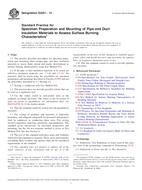Potrebujeme váš súhlas na využitie jednotlivých dát, aby sa vám okrem iného mohli ukazovať informácie týkajúce sa vašich záujmov. Súhlas udelíte kliknutím na tlačidlo „OK“.
ASTM E2231-14
Standard Practice for Specimen Preparation and Mounting of Pipe and Duct Insulation Materials to Assess Surface Burning Characteristics
Automaticky preložený názov:
Štandardná prax pre prípravu vzoriek a Montáž potrubia a izolácie potrubia materiálov hodnotením žeravom povrchu Charakteristika
NORMA vydaná dňa 15.3.2014
Informácie o norme:
Označenie normy: ASTM E2231-14
Poznámka: NEPLATNÁ
Dátum vydania normy: 15.3.2014
Kód tovaru: NS-44740
Počet strán: 8
Približná hmotnosť: 24 g (0.05 libier)
Krajina: Americká technická norma
Kategória: Technické normy ASTM
Anotácia textu normy ASTM E2231-14 :
Keywords:
ICS Number Code 13.220.50 (Fire-resistance of building materials and elements)
Doplňujúce informácie
| Significance and Use | ||||||||||||||||||
|
5.1 Pipe and duct insulation systems are often evaluated with Test Method E84 to comply with building or mechanical code requirements. This practice describes, in detail, specimen preparation and mounting procedures for single-component pipe or duct insulation systems and for multi-component pipe or duct insulation systems. 5.2 The material, system, composite, or assembly tested shall be representative of the completed insulation system used in actual field installations, in terms of the components, including their respective thicknesses. 5.3 Pipe and duct insulation systems consist of a variety of materials and constructions. 5.4 Some testing laboratories have developed a number of protocols for testing pipe or duct insulation systems which utilize one generic type of materials, all of them with an insulation core and a jacket. Those protocols are the origin of this practice, which makes them generic, to reduce material bias in the standard; they have resulted in the procedures presented in 5.5 This practice addresses specimen preparation and mounting of systems of the types described in 5.5.1 Multi-component systems containing an insulation core and a jacket, with or without adhesive between insulation core and jacket, not intended to be bonded to a pipe or duct substrate. Specimen preparation and mounting for such systems is described in 6.1 if they are self-supporting and in 5.5.2 Single component systems, not intended to be bonded to a pipe or duct substrate. Specimen preparation and mounting for such systems is described in 5.5.3 Systems intended to be bonded to a pipe or duct substrate. Specimen preparation and mounting for such systems is described in 6.5. 5.5.4 Reflective insulation materials (see 5.5.5 Specimen preparation and mounting procedures for systems not described in this practice shall be added as the information becomes available. 5.6 Supplementary Materials: 5.6.1 It is recognized that supplementary materials for pipe or duct insulation systems are normally able to generate heat, flame or smoke. Thus, the fire safety of the entire system depends, at least to some extent, on the fire performance of supplementary materials. Consequently, the fire-test-response characteristics of all supplementary materials shall be assessed to obtain a full assessment of the fire-test-response of the pipe or duct insulation system. See 5.6.2 Supplementary materials are often present intermittently spaced, and not for an extended length, in a pipe or duct insulation system. Thus, it is not always possible to suitably test them in conjunction with a pipe or duct insulation system. 5.6.3 Testing of Supplementary Materials—Supplementary materials that have not been fully tested in conjunction with the pipe or duct insulation system, in accordance with Section 5.7 The limitations for this procedure are those associated with Test Method E84. |
||||||||||||||||||
| 1. Scope | ||||||||||||||||||
|
1.1 This practice describes procedures for specimen preparation and mounting when testing pipe and duct insulation materials to assess flame spread and smoke development as surface burning characteristics using Test Method E84. 1.2 If the pipe or duct insulation materials to be tested are reflective insulation materials (see 1.3 Testing is conducted with Test Method E84. 1.4 This practice does not provide pass/fail criteria that can be used as a regulatory tool. 1.5 Use the values stated in inch-pound units as the standard, in referee decisions. The values in the SI system of units are given in parentheses, for information only; see IEEE/ASTM SI-10 for further details. 1.6 This fire standard cannot be used to provide quantitative measures. 1.7 Fire testing of products and materials is inherently hazardous, and adequate safeguards for personnel and property shall be employed in conducting these tests. Fire testing involves hazardous materials, operations, and equipment. This standard gives instructions on specimen preparation and mounting, but the fire-test-response method is given in Test Method E84. See also Section 8. 1.8 The text of this standard references notes and footnotes which provide explanatory material. These notes and footnotes (excluding those in tables and figures) shall not be considered requirements of the standard. 1.9 This standard does not purport to address all of the safety concerns, if any, associated with its use. It is the responsibility of the user of this standard to establish appropriate safety and health practices and determine the applicability of regulatory limitations prior to use. 1.10 This fire standard cannot be used to provide quantitative measures. |
||||||||||||||||||
| 2. Referenced Documents | ||||||||||||||||||
|
Odporúčame:
Aktualizácia technických noriem
Chcete mať istotu, že používate len platné technické normy?
Ponúkame Vám riešenie, ktoré Vám zaistí mesačný prehľad o aktuálnosti noriem, ktoré používate.
Chcete vedieť viac informácií ? Pozrite sa na túto stránku.




 Cookies
Cookies
